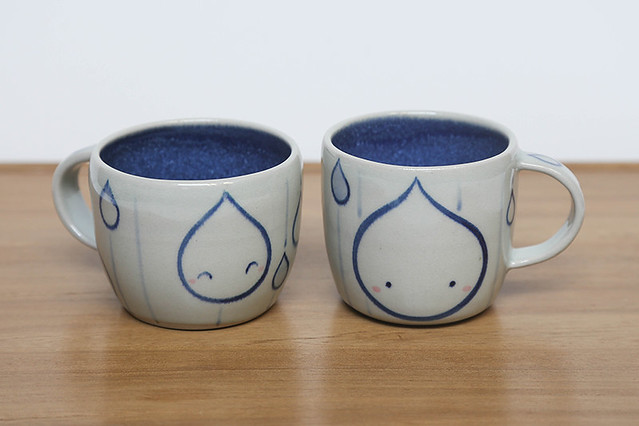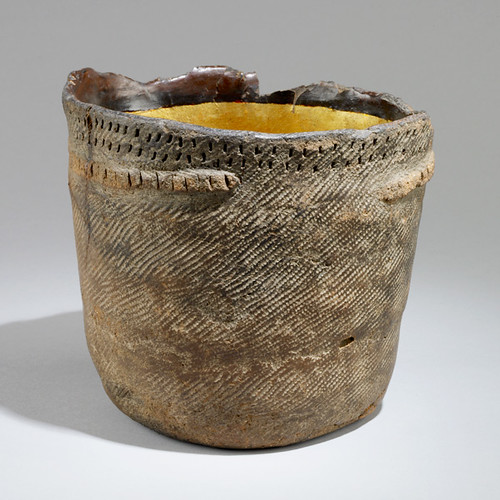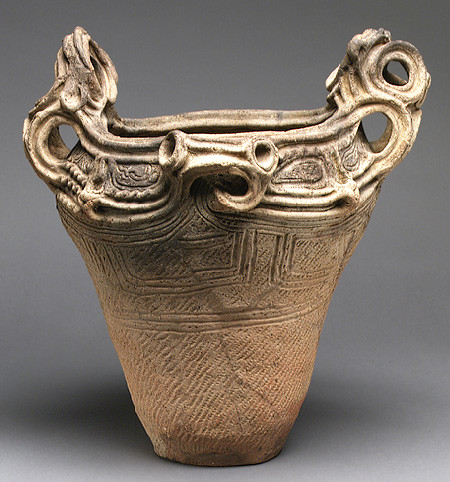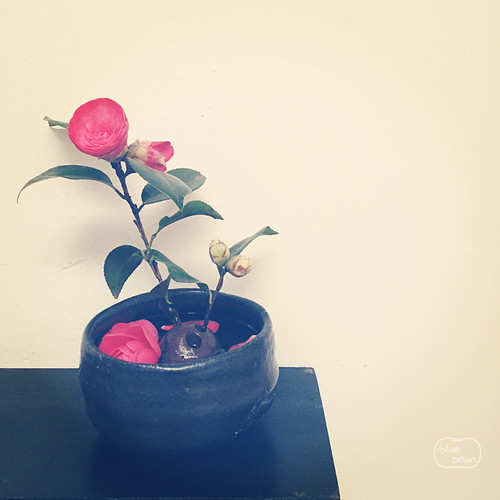|
|
|
|
|
|
|
Forecast: Rain & Clouds Ahead
|
|
|
|
Yup, Fall is well under way and with it, the gray skies and drizzle that seem to run from one day into the next. To be clear, I’m not knocking Fall, I’m merely describing the reality of this season in the Pacific Northwest. As a matter of fact, this particular characteristic of Seattle weather has been an inspiration for me and here is the evidence of that…

As mentioned in a previous post, the raindrop motif has been a recurrent one for me. When I first began using it in my cobalt blue hand painting a couple of years ago, it was in part to help me cope with my impending move to Seattle after spending a couple years abroad in China. I have since continued to use it because I just think they’re a lot of fun to paint (not to mention I love each little raindrop character : ).

Recently I’ve been playing with different glaze colors and have even started experimenting with clouds as a related motif. So far, I’m liking what I see!


I think I’ll be making more of these… and I have the entire rainy season ahead of me to keep me at work indoors. But really, I actually love hearing the pitter patter of rain outside, provided I’m warm and dry inside… and can cozy up with a mug of something steaming hot (perfect in one of these little mugs, don’t you think?).
|
|
|
|
|
|
|
|
|
|
|
|
Liking mistakes
|
|
|
|
Oops… just realized I had a bit of a blogging lapse there. I’ve been having a couple of not-so-great days in the studio — stumbling around, making mistakes, feeling slightly “off.” My main frustrations are with learning to use a different clay and, perhaps more importantly, trying to figure out what I want to focus on creatively.
I stumbled across the following video of Chris Staley (Penn State Laureate 2012-2013) a few weeks ago. I found it very moving and thought this would be a fitting time to share it.
There are a couple parts that really resonated with me. Chris talks about how things are all interconnected and about life as a matter of heart. He gets quite choked up as he talks about how life is more than finding ways to validate ourselves: “Life is so much more than that… life is about feelings, and emotions and how we connect with one another.”
As to creativity, he discusses the “craftsmanship of risk” — the reality that when we make something with our hands we don’t know what our hands are going to do, that there is a “degree of unpredictability.” I think he poignantly encapsulates the whole idea of handmade creative work. Even the act of painting a line may not turn out the way we intend or expect it to. This unpredictability is the beautiful result of our bodies being made of hundreds of thousands of neurons that must coordinate in order for every action to take place. Even if my hands are being tasked by my brain to carefully paint a thin line, my legs have to cooperate and stay still. As such, a tiny jerk of the knee and my line goes askew. It’s because I’m human.
Mistakes are humanizing. We need not let them paralyze us. They are part of the human story. And sometimes our stories get poured into the objects we make.
“In some small way… all the cups and all the pots have a story. They’re more than just objects… they’ve been touched by the people that made them and obviously, in some way, they have touched our lives by using them everyday.” - Chris Staley
|
|
|
|
|
|
|
|
|
|
|
|
A year after Jingdezhen
|
|
|
|
About this time last year, I was halfway across the world, in Jingdezhen, China. I had made a last-minute decision to join a friend on a road trip to the “porcelain capital” — he to do a soda firing, I to see how the city would inspire me once more.
I still recall how cool it was to observe the changing landscape as we drove out of Shanghai and through the outskirts into a different province. As it turned out, I got my inspiration well before we arrived in Jingdezhen.

So much has happened since that last trip to Jingdezhen, but some of the most memorable moments during my time in China come from that place.
|
|
|
|
|
|
|
|
|
|
|
|
The original Rope Series by the Jōmon
|
|
|
|
Last week, I introduced the blue bean studio Rope Series. So what better time than now to talk about the *original* Rope pottery?
Before the blue bean studio Rope Series, there was Jōmon pottery.
When I first started focusing on using rope to texture and decorate my pieces, I was told that it had been done before. Of course, I wasn’t surprised to hear that; after all, most ideas are not entirely new and are birthed out of other existing ideas.
But then I looked deeper into the matter and discovered that not only had it been done before, it had been done on some of the oldest pots ever discovered anywhere in the world.
The pottery I am referring to date as far back as 14,000 BC (that’s OLD!) and come from Aomori in northern Japan. These ancient pottery fragments, called “Jōmon” ware, were first discovered near Tokyo in 1877.

The term “Jōmon” (縄文) means “rope-patterned” in Japanese, and describes the characteristic twisted cord patterns impressed on to the surface of the clay. An entire period in the prehistory of Japan, the Jōmon Period, lasting from around 14,000 to 300 BC, is named after this style of pottery, which was produced throughout that time. The very long Jōmon Period is further divided into six phases.
The Jōmon peoples have been described as hunter-gatherers who later became semi-sedentary. The typically small vessels associated with them were probably used to boil and eat food. As the people settled into more sedentary lifestyles, their vessels increased in size. The pottery produced during the Jōmon period has been classified into about seventy different styles, with additional regional variations.

While I did not draw inspiration directly from the ancient Jōmon pottery, I find it intriguing that, when given the opportunity, I had the same desire to impress rope patterns into wet clay as did humans who lived over 15,000 years ago. In a very similar (if not identical) manner, we chose to use a “regular” object to create texture and decoration on our pottery, to make more beautiful a functional object. What does that say about me? What does that say about the Jōmon people?
Perhaps we have not changed so much…
|
|
|
|
|
|
|
|
|
|
|
|
Wabi Sabi What?
|
|
|
|

One of the first things I was encouraged to do when I started my journey in ceramics was to “let go.” Specifically, I was to let go of my need for perfection. As a former (but sometimes still practicing) perfectionist, that was very difficult advice to take seriously. But if you work long enough with natural materials, you learn quickly that they do not lend themselves to perfect surfaces, lines and symmetries.
Then one day as I was lamenting about a piece that came out of the kiln with funny glaze drips, somebody told me it was “wabi sabi.” Being unfamiliar with the term, I looked it up. Wikipedia, as usual, came through with a helpful description.
“Wabi-sabi represents a comprehensive Japanese world view or aesthetic centered on the acceptance of transience and imperfection. The aesthetic is sometimes described as one of beauty that is “imperfect, impermanent, and incomplete”… Characteristics of the wabi-sabi aesthetic include asymmetry, asperity (roughness or irregularity), simplicity, economy, austerity, modesty, intimacy and appreciation of the ingenuous integrity of natural objects and processes.
Wabi now connotes rustic simplicity, freshness or quietness, and can be applied to both natural and human-made objects, or understated elegance. It can also refer to quirks and anomalies arising from the process of construction, which add uniqueness and elegance to the object. Sabi is beauty or serenity that comes with age, when the life of the object and its impermanence are evidenced in its patina and wear, or in any visible repairs.”
While the wabi sabi aesthetic has roots in the tradition and culture of Zen buddhism, the term has crossed over into more casual use within modern vernacular. It is interesting to note that for all the words used to describe the essence of wabi sabi, it is an idea that is often difficult to put a finger on, especially for those who look at it from a deeper perspective or practice it as a way of life.
Even so, if I may move this discussion away from the philosophical arena, I think the general, more shallow, overarching concept can be applied across cultures. One need only to look closer at the environment that surrounds him to find that very few things in nature are considered “perfect.” One will also observe that that which is subject to the elements will be shaped by them over time.
For the potter, there is a freedom that comes in embracing the imperfect. The bowl shown in the photo above, made by the studio manager, is an example of how wabi sabi may be translated into pottery. Its shape is not perfectly round, its surface displays irregularities, and its color echoes that of a rock. The form is clearly not manufactured in a mass production line but bears the marks of a personal creator.
But it’s one thing to let go of perfection and another thing to actually embrace imperfection. Even as I am still walking along that continuum from accepting that things will not be perfect to celebrating it, I can honestly say that I have come to appreciate the beauty and uniqueness that result from natural and uncontrolled processes… flaws and all.
|
|
|
|
|
|
|
|
|
|
|
|
Historical figures
|
|
|
|

The turquoise and coral colors on this shelf of old porcelain figurines caught my eye…
I love how there are so many little details to explore on these shelves. Look closely and you’ll discover little bits of Chinese history going on here — items alluding to China’s imperial past, recent Communist era (including a slumbering Mao), and of course its rich ceramics tradition.
|
|
|
|
|
|
|
|
|
|
|
|
Creativity and Courage
|
|
|
|
Sometimes I need a kick in the bottom to get me back on to the creative track. Having self-declared 2013 my “Year of Creativity,” I have collected some inspiring words and nuggets (or beans, if you will) of wisdom to ponder and to fuel the process. Once in a while, I’ll share those words here…
At the beginning of the year, I was encouraged to write down one attribute that described who I was, and two attributes that I wanted to grow over the next twelve months. I like the following quote as it incorporates two of the three attributes I wrote down: “creative” and “courage.”

I am reminded that anything worth doing often requires us to first take a step and act beyond what we would normally be comfortable doing; and being creative is just one of those things.
|
|
|
|
|
|
|
|
|
|
|
|
 |
|
|

